The 8 best perfect-for-privacy garden trees
Your perfect-for-privacy garden trees are the not the same as anyone else’s.
This post will show you how to choose the right privacy tree for your garden. And it’ll also help you choose the right tree for the problem.
Perhaps you have a neighbour’s window over-looking your garden, but you only really need privacy in the summer? In that case, a deciduous tree, which loses its leaves in winter, will also give you glorious autumn colour.
But if you want to screen an ugly view or a street-lamp which shines into your windows, you’ll need an evergreen tree. That will keep its leaves – and your privacy – all year round.
But the days of planting a row of gloomy conifers all along your fence line in order to give you privacy over. They can even be illegal if they get too tall.
Top 10 privacy garden trees
- Ornamental pear ‘Chanticleer’ (Pyrus calleyrana ‘Chanticleer’) – deciduous
- Magnolia grandiflora – evergreen
- Holm oak (Quercus ilex) -evergreen
- English holly (Ilex aquifolium) – evergreen
- Amelanchier lamarkii (also known as Juneberry) – deciduous
- Hornbeam (Carpinus betulus) – leaves die in winter but stay on the tree
- Ornamental cherry ‘Snow Goose’ (Prunus ‘Snow Goose) – deciduous
- Crab apple tree – especially Malus hupehensis
- A large shrub, such as Cherry Laurel (Prunus laurocerasus).
- A multi-stemmed tree, usually silver birch or amelanchier – deciduous
But before buying one, read more about it to check it’s perfect for you! (There’s more about each in this post, updated in 2023).
If you’re interested in all aspects of your garden privacy, then see my book, The Complete Guide to Garden Privacy, available as a Kindle ebook or a paperback in up to 13 countries.
And if you want to read it on a tablet or pc, The Complete Guide to Garden Privacy, is also available as a pdf download.
And here’s what you need to know about finding a beautiful tree to make your garden more private and which won’t block too much light.
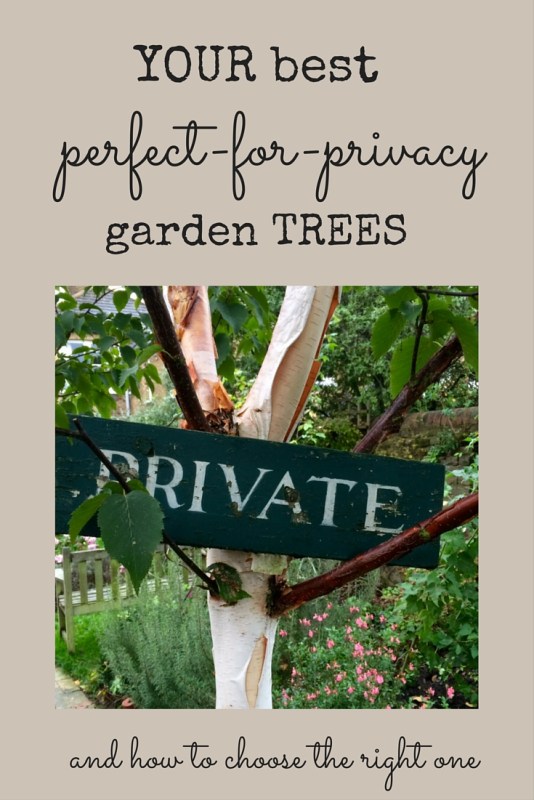
The right tree in the right place adds up to your perfect-for-privacy garden trees.
Before deciding on your privacy garden trees…
There is no single ‘perfect-for-privacy garden tree’. But there is the right tree for your garden privacy.
And the starting point is your climate, your soil, how big your garden is and what grows well in it. Before making a short-list of trees, read this post on how to choose the right tree for your garden.
It’s also important to remember you don’t often need a whole row of trees. If only one neighbouring window can see directly into your garden, then you just need one tree, placed in the line of sight between your garden and that window.
Don’t plant a row of trees for privacy right along your fence line. If they grow too high, they’ll make your garden dark. And they often don’t give you as much privacy as you think they will.
Here’s more about garden privacy and lines of sight.
How to choose trees for privacy
Firstly, do you need a fast growing tree When you talk to tree suppliers, ask how fast a tree grows and how high it will get. Young trees are cheaper and often establish better.
But if you want privacy soon, then consider how fast the tree grows.
If a tree is slow-growing, then mature specimens will be very expensive. But young trees will take years to get to where you want them.
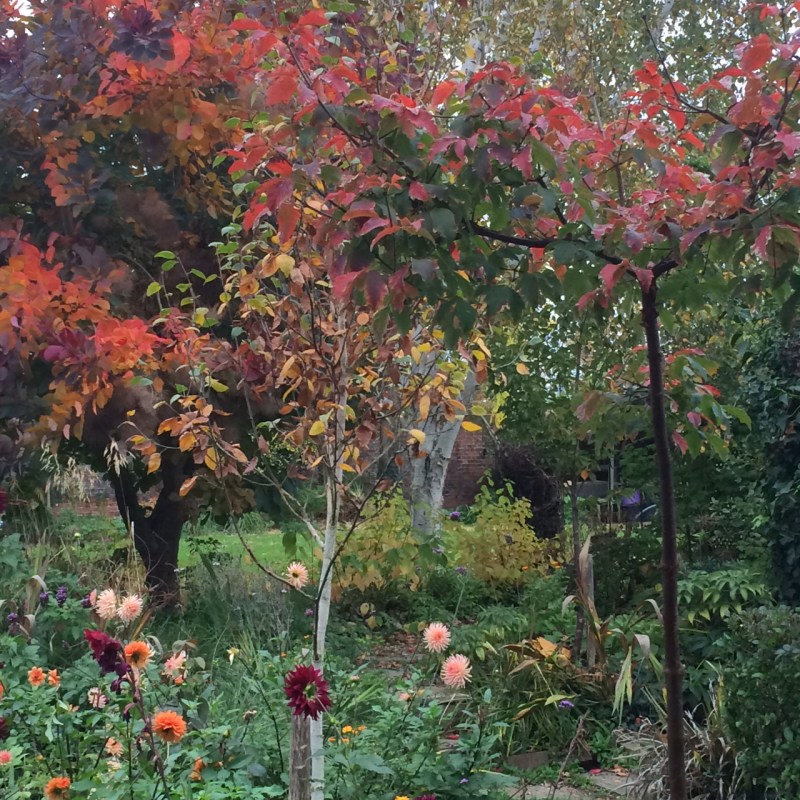
Acer Griseum (Paperbark Maple) is the little tree on the right. It has beautiful colouring, but is now about 6ft high. It will take 10 years or more to get to the size you would probably want for privacy garden trees.
We were originally recommended Acer Griseum (Paper-bark Maple) as ‘the most beautiful garden tree’. It is glorious, but too slow-growing for privacy.
But, on the other hand, planting a fast-growing tree close to your house can cause problems if the tree gets too big. Before buying a tree, check how big it grows. If you want to plant it near your house, it should be at least three-quarters of its eventual height away. So a tree that grows to 15ft can be planted 10ft away from the house. But a tree that grows to 60ft needs to be 40ft away from the house, unless you plan to keep it pruned to a much smaller size.
For privacy from neighbours, think about the tree shape
If you want to increase your privacy from your neighbours, then the shape of the tree is important.
You (and they) will want a tree that doesn’t shade your gardens too much. An upright, vase-shaped or tear-drop tree won’t spread its branches all over your neighbour’s garden.
Tear-drop shaped ‘perfect for privacy’ garden trees include Ornamental Pear (Pyrus calleyrana) and Ornamental cherry (Prunus ‘Snow Goose’).
If you choose a tree withr tree’s branches do cross into another person’s garden, they are legally entitled to cut them off.
There are a number of trees which are quite large for small gardens. But they can be pruned or shaped to make them work. Remember that will mean yearly maintenance, however. Read Jamie Butterworth’s advice and ideas in this post on trees for small gardens.
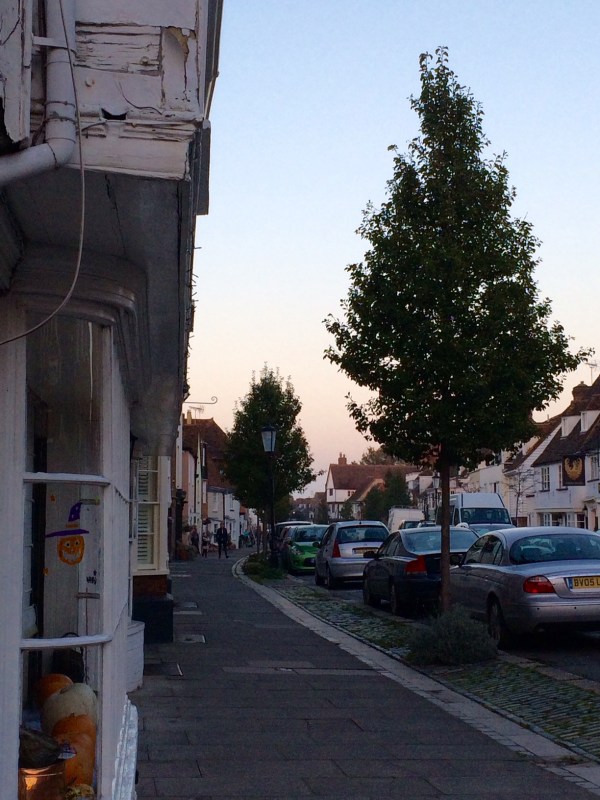
The neat teardrop shape of Pyrus calleyrana ‘Chanticleer’ in Abbey St, Faversham, is a favourite for screening. You can see that it doesn’t cast much shade.
Pyrus calleyrana ‘Chanticleer’ – the privacy tree for small gardens
Ornamental pear (Pyrus calleyrana ‘Chanticleer’) is often called the perfect privacy tree for small gardens.
That’s because the shape of a tree makes a big difference to how much shadow it casts. Ornamental Pear has a tear-drop shape. That means most leaves are in a neat shape around the height of a first floor window. There’s not too much shadow cast over the ground.
Award-winning garden designer, Charlotte Rowe, has often used Ornamental Pear (Pyrus calleyrana) ‘Chanticleer’, including in her own garden. People call it ‘the perfect street tree’. It’s easy to grow in any aspect, windproof, generally pest-free, low maintenance and tolerates air pollution. It has beautiful white spring blossom and good autumn colour.
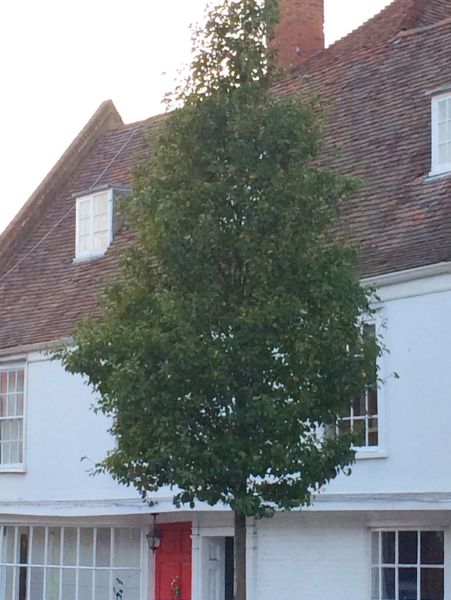
Abbey St in Faversham is lined with Pyrus calleyrana ‘Chanticleer’. Its roots won’t affect pavements or basements and it has glorious spring blossom and autumn colour.
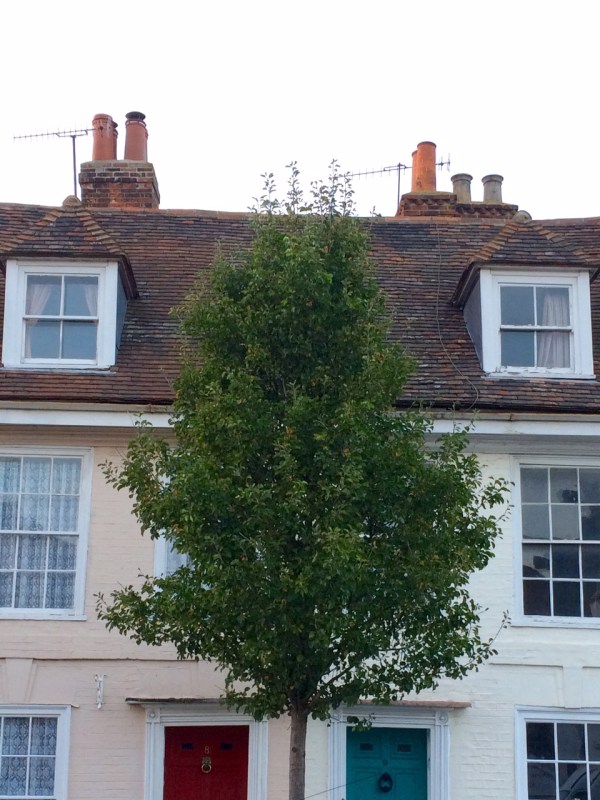
The leaves aren’t too dense – these upper windows in Faversham are private without being too dark. The upright habit of ‘Chanticleer’ means that it won’t dominate a small garden the way a spreading tree would.
Evergreen magnolia for year-round privacy
Think about when you want the privacy. If you only want privacy when you are in your garden in summer, then a tree which loses its leaves in winter may be fine.
But if you are blocking an eyesore, then you will want an evergreen tree for year-round screening.
We have an evergreen magnolia grandiflora directly in front of an ugly, glaring streetlamp. It has thick green leaves but doesn’t spread over the alleyway behind it. It’s not large enough to have a major impact on the neighbour’s garden beyond.
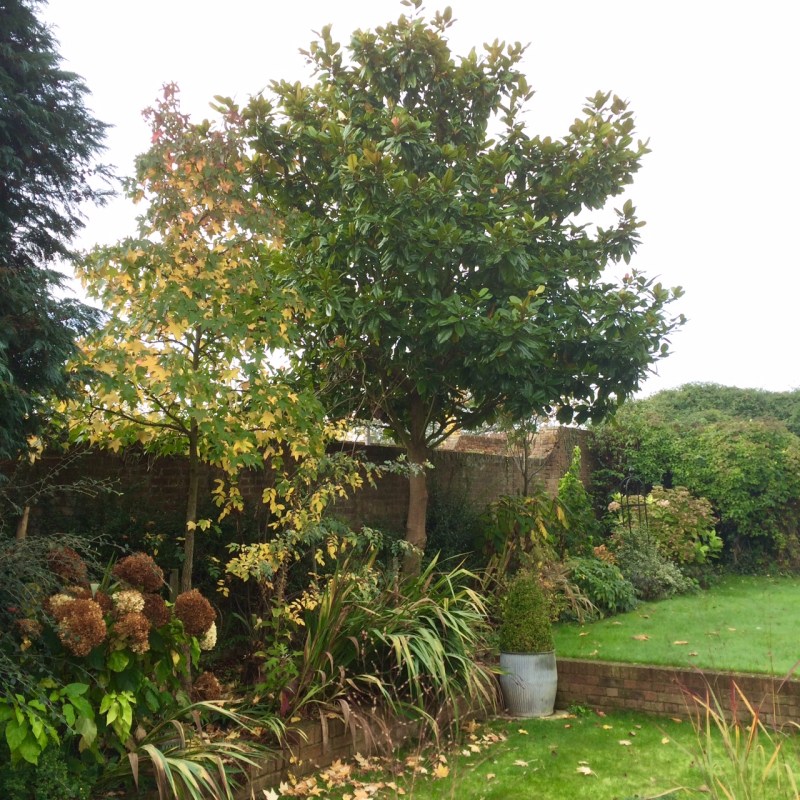
Our Magnolia Grandiflora is a good block against a harsh street lamp. The tree in front of it is Liquidambar, which – even in full leaf – will never block harsh light.
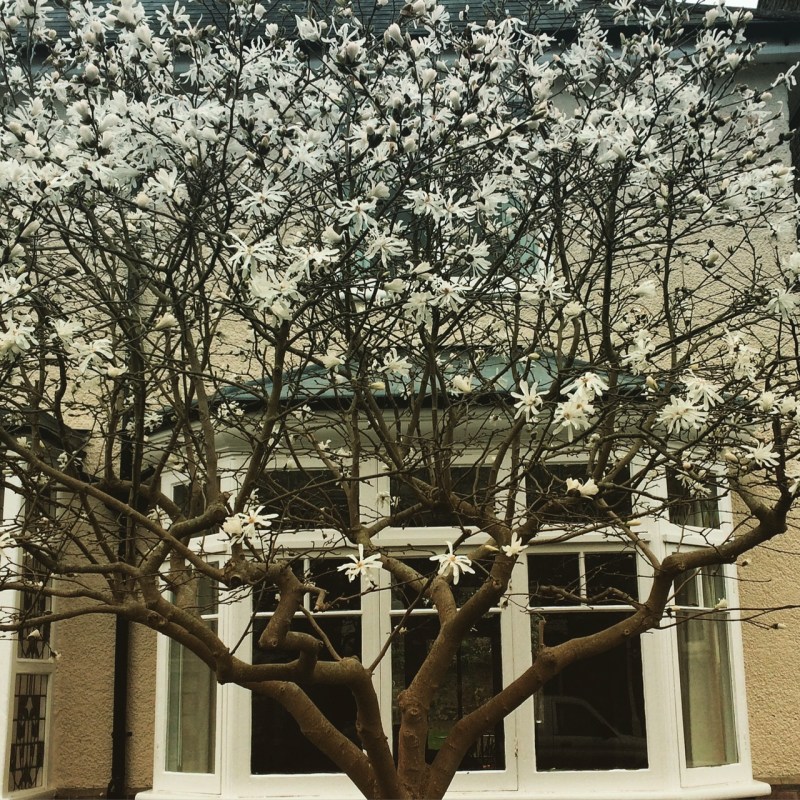
Not all magnolias are evergreen – here Sarah Langton-Lockton’s Magnolia loebneri ‘Merrill’ makes a wonderful screen for an upper bedroom from spring onwards.
More evergreen trees for privacy
Many evergreen trees, such as conifers, can grow very big. They’re not suitable for small gardens.
However, one way of blocking a specific view would be to plant an evergreen tree and to keep it tightly clipped. You will need to have it clipped at least once a year. And if you’re not physically able to do that yourself, then you’ll need to budget for a once-a-year visit from a tree surgeon.
Or you can combine privacy with a dramatic focal point in your garden by topiarising the tree. That just means cutting it into an interesting shape.
Holm oak (Quercus ilex)
This evergreen tree cuts into shape very well. If you keep it trimmed, you can keep it the size and shape you want.
And you can topiarise it.Large topiary trees are very expensive, but we created our over around 5 years by buying two very young holm oaks cheaply. Once they’d been established for a few years, we had them cut into topiary shapes. You could, however, do a much simpler shape and do it yourself.
English Holly (Ilex aquifolium)
People think of holly as a bush rather than a tree. But like holm oak, you can trim it into the shape and size you want. The holly below (on the right) was originally just a big shrub. We had it cut into topiary. If a shrub is already established, it will take 2-3 years before the topiary shape is sharp and exact, because the growth takes time to establish where you want it.
Good evergreen trees for regular clipping and shaping include yew and holm oak.
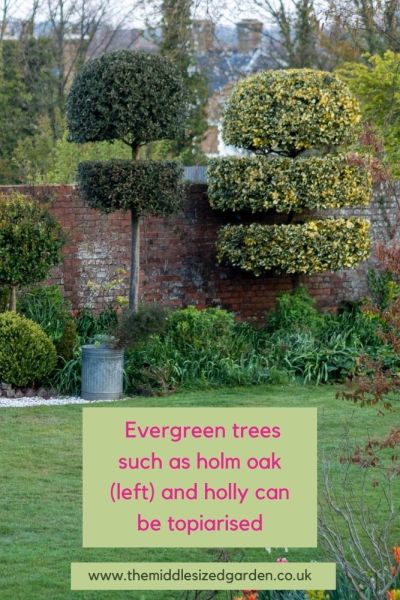
The tree on the left is a topiarised holm oak. On the right, English holly ‘Golden King’ has been shaped into tiers. If you want to block a single area, such as a view from a window or an ugly streetlamp, then you can shape or cut an evergreen tree. It’ll also make a dramatic focal point. It will need trimming once a year.
Amelanchier – the tree to replace net curtains
You may want trees for privacy from the street, especially at bedroom height. Or you may just prefer to wake up in the morning looking at leaves rather than streetlamps and houses.
Amelanchier is deciduous and loses its leaves in winter – but, on the other hand, you probably keep your curtains closed for longer in winter.
Amelanchier has a ‘vase’ shape and its glorious colour makes it a good privacy tree. You also have plenty of space (and enough light) at ground level to plant other things.
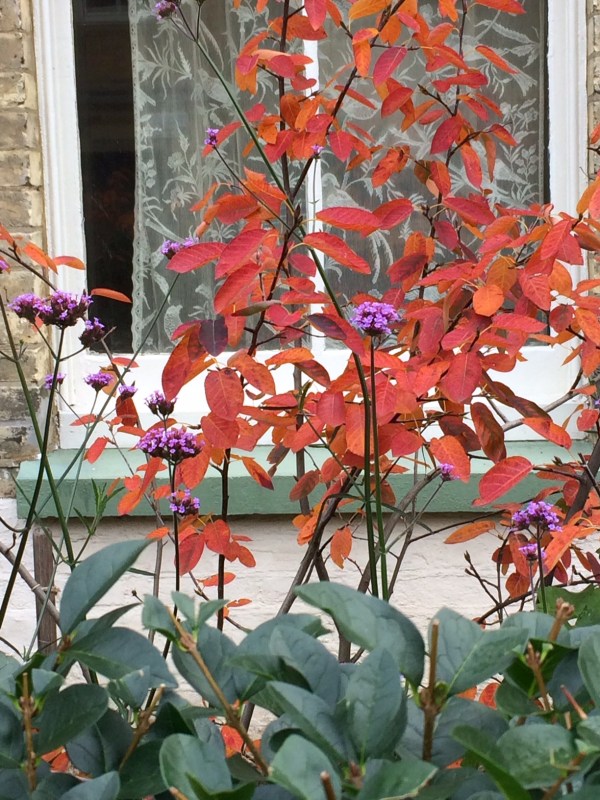
Posy Gentles has replaced a conifer in her front garden with a vase-shaped amelanchier. It has beautiful blossom in spring and gorgeous autumn colour. It’ll probably take two years before it screens the living room window completely.
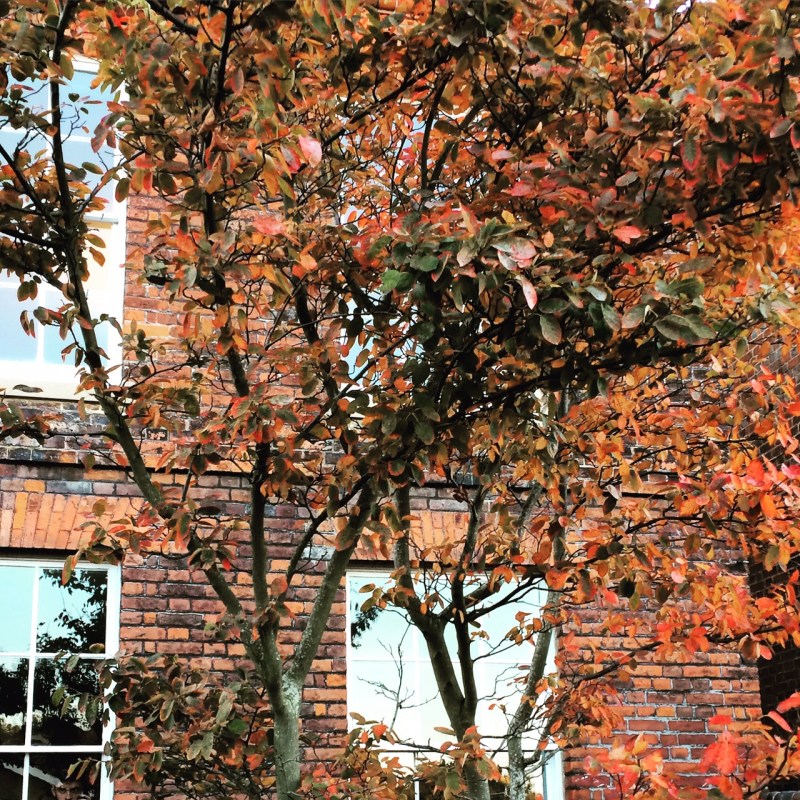
My neighbour’s amelanchier offers light-dappled privacy and turns the colour of the house’s brickwork in autumn. It has, however, taken 12 years to get to around 30ft from a small tree.
Pleached hornbeam – good for privacy from the street
‘You shouldn’t have a row of evergreens along a boundary with a neighbour if it’s going to cause any problems with their light,’ says Charlotte Rowe. ‘And that often applies to pleached trees too, depending on the situation.’
However, there’s no doubt that a row of pleached hornbeam is very much more attractive and less light-sapping than a row of towering conifers.
Garden designers often use rows of pleached trees in city gardens – although Charlotte says she is more likely to use trellis than a tree if a client wants privacy in a small city garden.
Pleached trees are a great option for privacy from a road or blotting out an eyesore. ‘Carpinus betula (hornbeam) is a good choice as an individual tree for privacy in a town garden, too,’ she says, ‘as it’s relatively fast-growing but doesn’t get too big.’
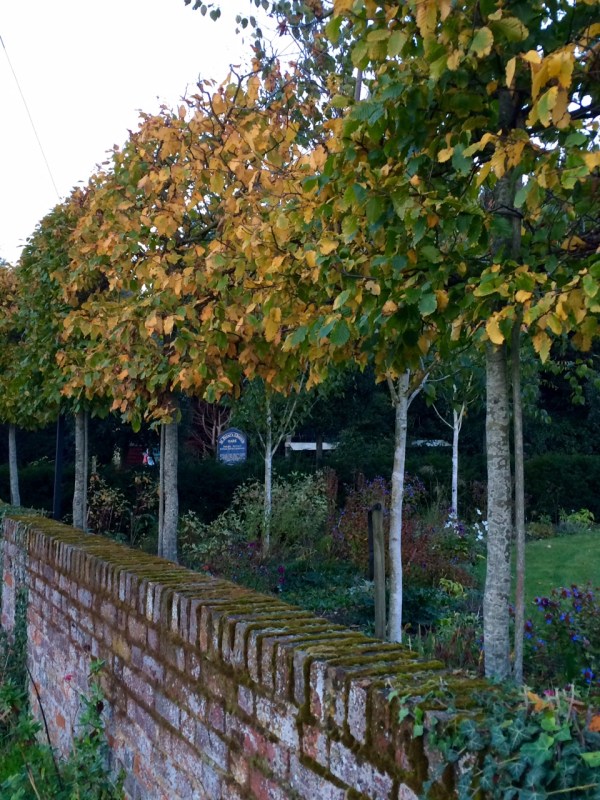
Using pleached hornbeams (Carpinus betula) for increased privacy from the road. These might be too high to use in a small town garden as they might block your neighbour’s light. But they are very pretty, so the neighbours might like them.
Ornamental plum trees – a good ornamental fruit tree for screening
You could also consider planting ornamental fruit trees for privacy. They have great blossom and beautiful leaf colour. Not all of them are an ideal shape for allowing light into the garden – the winter-flowering cherry that used to be in our garden had widely spreading branches, which affected our light (and our neighbour’s light).
So a more upright ornamental cherry would be a better choice. Our Prunus ‘Snow Goose’ has beautiful white spring blossom, glorious autumn colour and is a very upright shape so it doesn’t cast much shade. Definitely one of the best perfect-for-privacy garden trees!
And black cherry plum (Prunus cerasifera ‘Nigra’) has worked brilliantly in another part of our garden to mask some railway signalling. It has staggeringly beautiful pink blossom in spring, and a very upright (tear-drop) habit which, so far, hasn’t blocked any light.
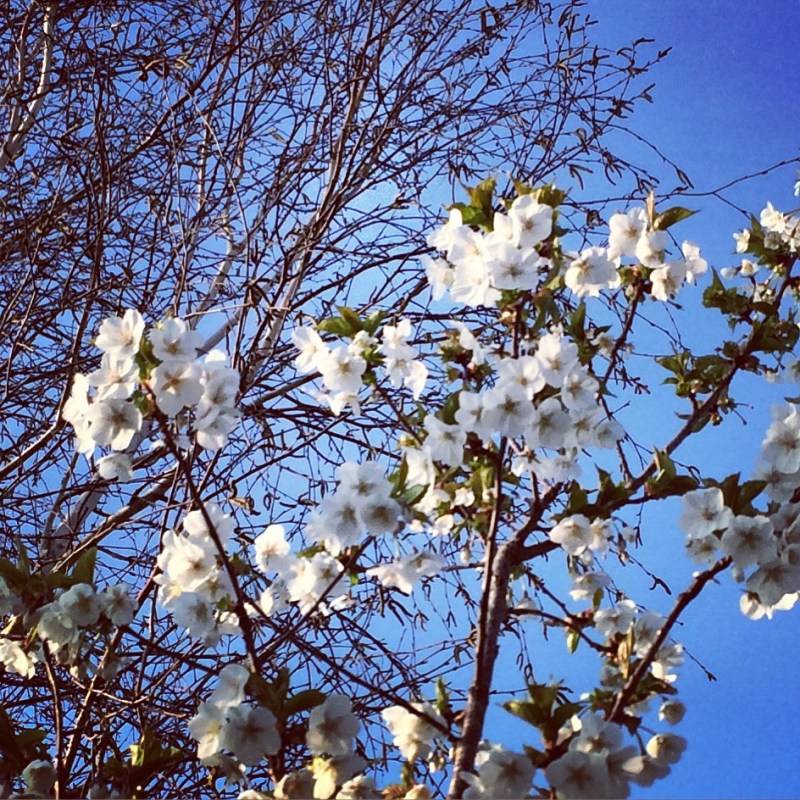
The white blossom of Prunus cerasifera ‘Nigra’ in spring. In summer it has dense, almost black leaves, but it is a compact and fast-growing tree – just what you need in that certain spot.
Perfect-for-privacy garden trees with fruit!
Apple trees and crab apple trees can offer privacy too, plus you get to enjoy the fruit. However, many fruit trees are sold on a dwarf rootstock, so check the eventual height before buying.
A tree for screening needs to be allowed to get bigger than a normal fruit tree. Fruit trees, however, rarely get enormous, so they’re a good choice for a middle-sized garden.
I am particularly fond of my two Malus hupehensis crab apples on either side of the front gate. They don’t exactly screen the road but they do give us a sense of enclosure and privacy when we step out of our front door.
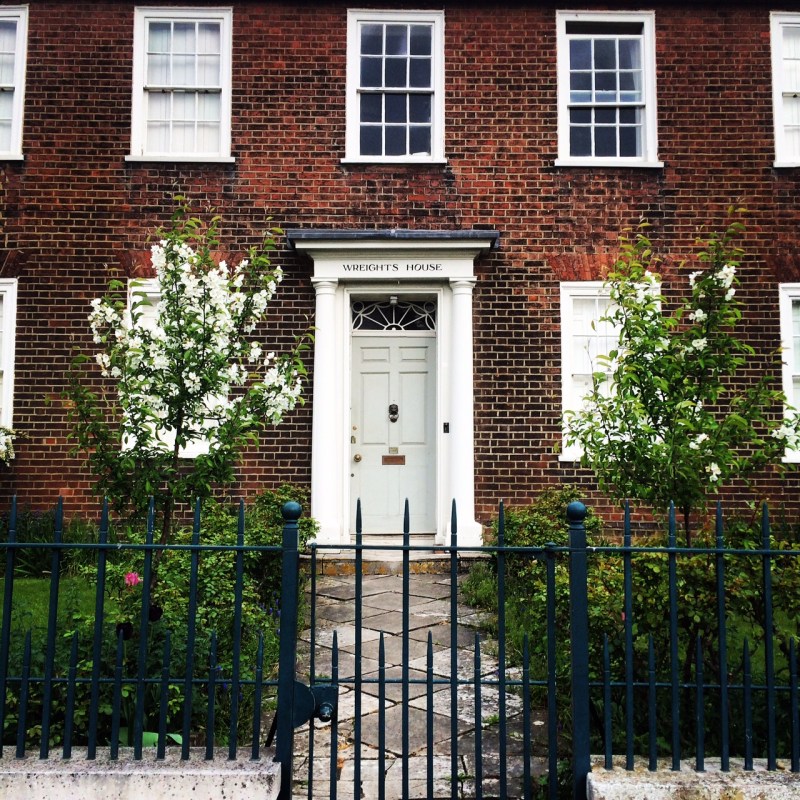
The two crab apples on either side of the gate are now five years old (from a pip). They screen the windows nearest the door from the road, and give us a sense of enclosure. This is their first spring blossom.
Try large shrubs instead of privacy garden trees
Instead of choosing a small tree, you could consider a large shrub. Some shrubs grow to the size of a small tree and are easier to shape. Garden designer, Caroline Garland, suggests laurel or photinia.
Another good screening shrub is cotinus or smokebush. We have Cotinus coggyria ‘Grace’ which is more normally grown as a shrub, but has turned into a huge, glowing red tree. Everybody comments on its glorious colour.
It’s a good example of a shrub that will grow big enough – fairly fast – to give you screening. It has a beautiful leaf – a deep red which turns into a blaze of autumn gold. And it seems pretty happy with any kind of a cut – you don’t have to let it get as big as ours has.
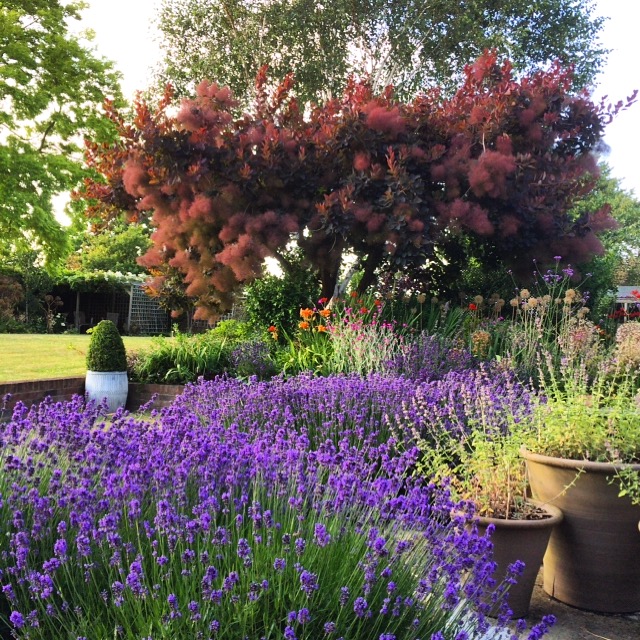
Cotinus coggyria ‘Grace’ is usually grown as a shrub, but it we have pruned it into a tree shape. We also got good black-leafed privacy from Sambucus Nigra ‘Black Lace’, which we grew against a wall and which took only a couple of years to shoot up to screening height.
Silver birch – beloved of ‘Chelsea’ garden designers (and me)
Silver birch has been seen so often at RHS Chelsea and other shows that some people may consider it to be a gardening cliche. But I love the pale bark in the winter, and the fact that it provides quick cover.
I have wanted a vase-shaped multi-stemmed birch for so long that I can’t understand why I haven’t bought a silver birch and cut it down, so that I’d have one by now. This would certainly be my choice for the current spot where we need screening – although the shape may not be quite right.
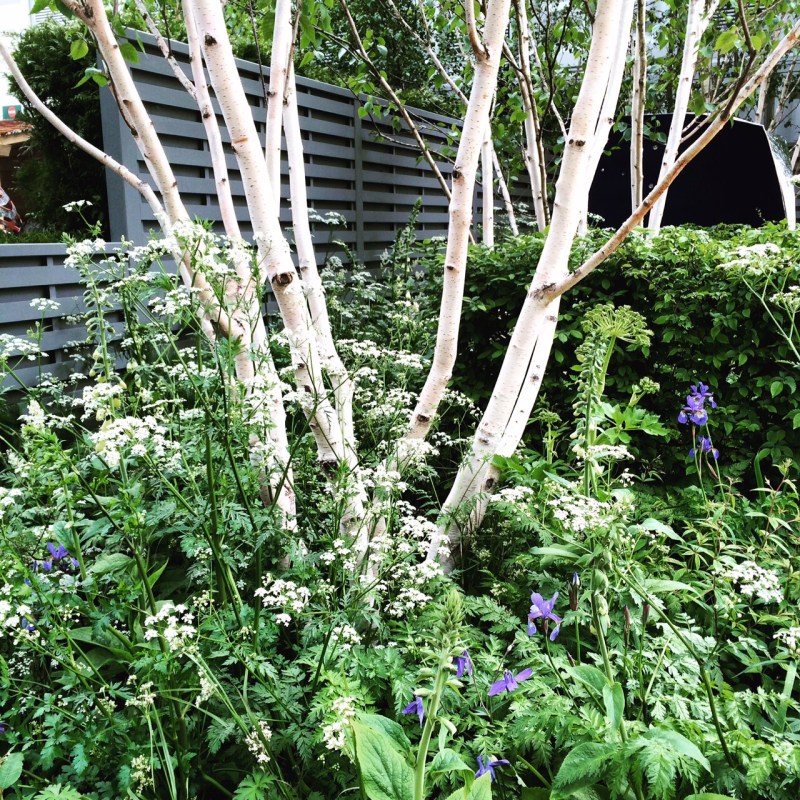
The Viking Cruises garden at RHS Chelsea used multi-stemmed silver birch and trellis to create ‘privacy’ in what could easily be any town garden. I really love this effect. If you don’t have space for several privacy garden trees, then a multi-stemmed tree could be the ideal solution.
Think about how leaf colour will work in your garden – robinia ‘Frisia’
Trees such as robinia and acacia have glorious leaf colour, but are considered ‘suburban’, says Caroline Garland. If you mainly need privacy in the summer, she recommends you look again at what these trees have to offer in terms of leaf colour. ‘I think they’re ready for a revival.’
We have a robinia ‘Frisia’ at the back of our garden, planted by our predecessors. It is definitely too big to be planted close to the house – but in the right position will offer summer leaf colour and a stunning effect.
Where you plant your privacy tree makes a big difference
Your instinct might be to plant trees around the edges of your property to leave as much space free in the middle as possible. However, that may upset your neighbours (unless they, too, would like more privacy). And it will also draw a visual line around your garden and make it look smaller.
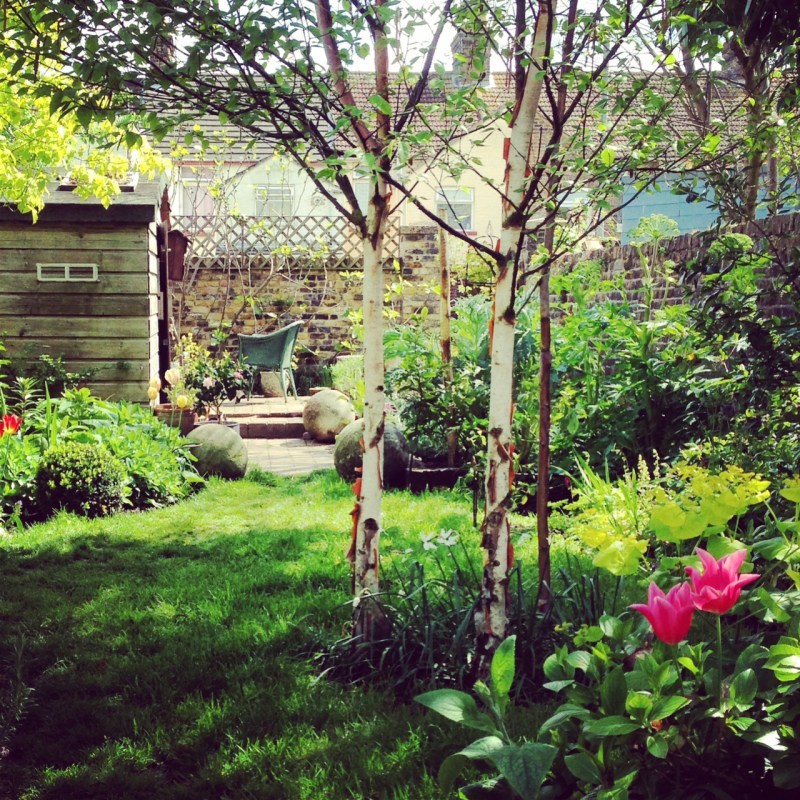
These three birch trees are planted close together, and positioned just off centre in Posy’s garden. Their canopy is more generous than a single birch, and therefore obscures the view of the back windows of the row of houses behind more quickly.
Garden maker Posy Gentles has planted three small birch trees slightly off-centre in the middle of her long thin town garden. You can see to the end of the garden but the exact outlines are blurred.
Both her garden and the back windows of her house are protected from the gaze of the houses opposite, but she’s not causing light problems for her neighbours. Posy’s trees are too far away from their gardens.
See how it works in video
Here’s a video with more ideas here for positioning trees for privacy.
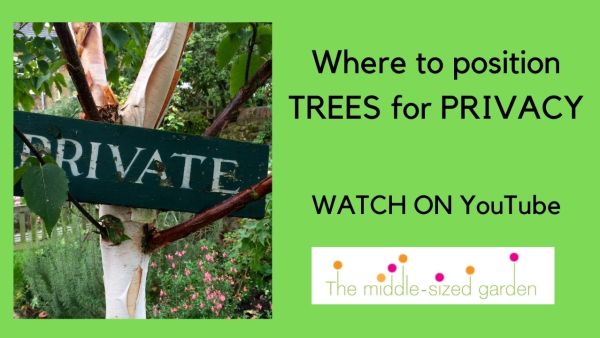
The same principle applies if you use trees for privacy in a larger garden. The laws of perspective mean that planting trees – for example – halfway between your house and what you want to block is more effective than trying to plant them too close to either building. And it leaves more light for everyone!
Alan Titchmarsh has written a very useful book called Small Trees in his How To Garden series. It lists trees suitable for middle-sized gardens along with how fast they grow, which soil they grow in, etc. There’s also pruning advice – once you plant your tree, it is well worth pruning it well.
If you’re starting out in gardening and want to know which are the best tools and books to buy, there are lists of my favourites on The Middlesized Garden Amazon storefront.
Note: There are some affiliate links in this post, which means you can click through to buy. If you do, I may get a small fee, but it won’t affect the price you pay. See disclosure.
You can also find more ideas for garden privacy here (fences for privacy) or here (evergreen hedges for privacy).
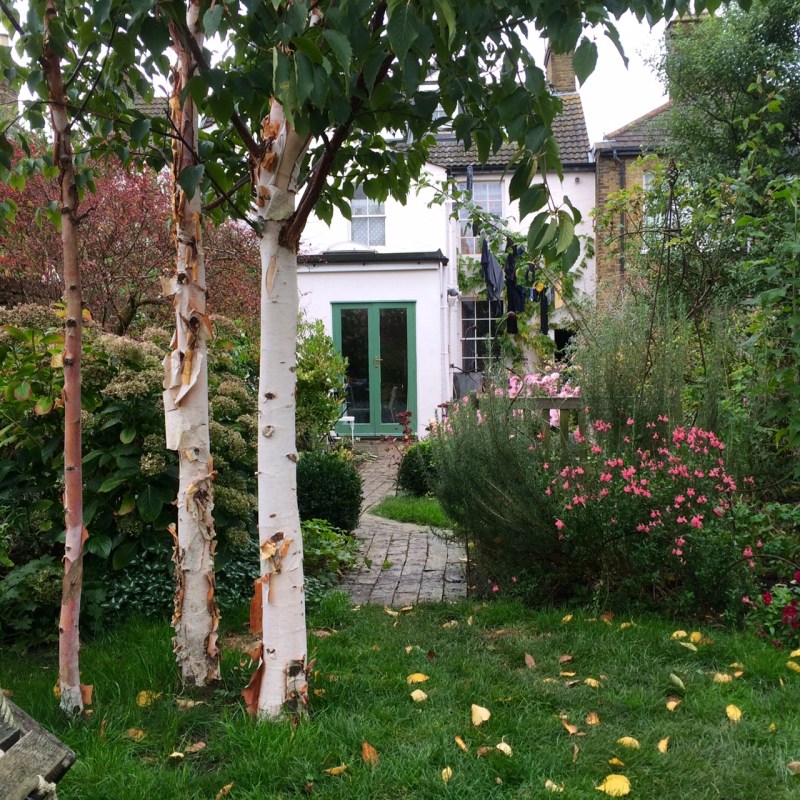
Looking back to the house with the three birch trees on the left. Planting three so close together means that they’ll never get toweringly tall as they will have to compete with each other.
How close to the house can you plant a tree?
The RHS says that a tree should be three-quarters of its height away from the house.
However, the RHS also stresses that trees benefit gardens and very rarely cause damage. The fear that people have of trees is largely unfounded. Trees that are least likely to cause problems to houses are apple, plum, pear, hawthorn, rowan and birch.
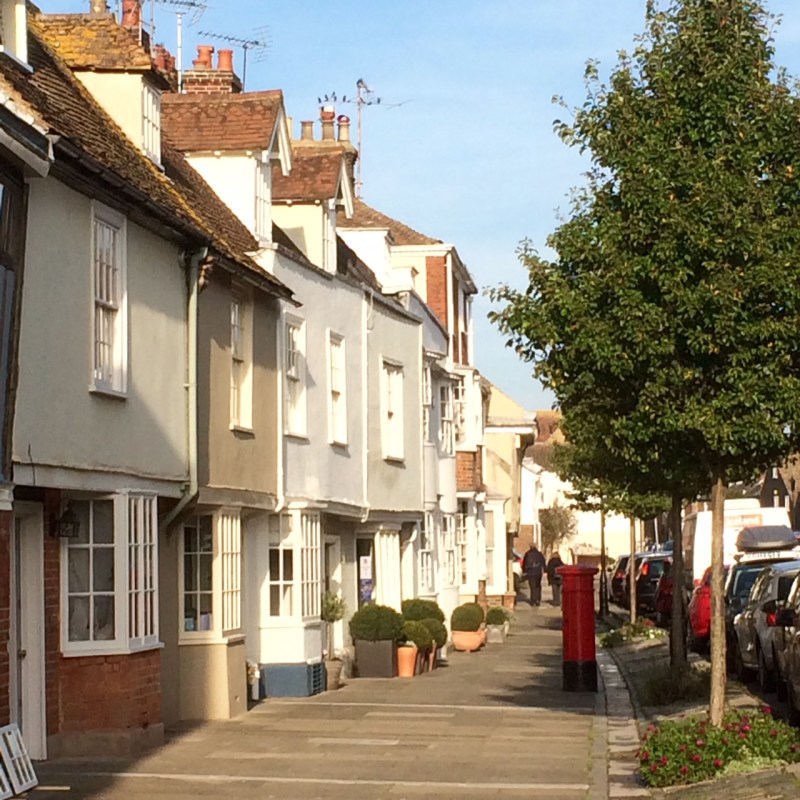
Pyrus calleyrana ‘Chanticleer’ is a good tree to plant near houses as its roots won’t damage foundations. In Abbey Street, Faversham, Kent. It’s planted roughly three-quarters of its height away from the building.
It’s also essential to plant your tree correctly. Badly planted trees are likely to die, possibly several years later. See this post for expert tips on how to plant a tree.
Pruning your tree can help with privacy and light
Are you thinking of taking a tree down because it is making your garden too shady? If you still want privacy, then consider pruning it instead. Thin the branches out or ‘lift the tree’s skirt’ by cutting off the lower branches.
Pruning trees well makes a huge difference to their impact on your garden, so consult a proper arboriculturalist rather than a handyman with a chainsaw. Find out more about privacy garden trees and light in my post on how to prune trees for privacy and light. Even if you’re not pruning the trees yourself, it’s important to recognise good pruning.
Of course, there is never a ‘best tree for privacy’ – there is only a ‘best tree for your privacy’. You have to take into account when you want the privacy and where to plant the tree.
Also consider how it will affect your neighbours and other factors, such as whether it’s good for wildlife.
So I hope this helps as a starting place, and do tell me which trees have worked for you. And if you’ve found this useful, do please share this using the buttons below – thank you!
The Complete Guide to Garden Privacy
Gardens are getting smaller and more over-looked. So making a private space is no longer just about planting the tallest tree possible. The Complete Guide to Garden Privacy shows you how to choose and combine trees, hedges, fences and screens for privacy. There is a chapter on which climbing plants to choose and how sheds, pergolas, arbours and trellis can help create a secret garden feel.
For a link to buy The Complete Guide to Garden Privacy in your country, see this list of Kindle and paperback editions around the world.
Or you can download it as a PDF from here to read on your tablet or pc if you don’t use Kindle. Or you could print it out.
The Middlesized Garden sustainable t-shirts, hoodies and tote bags…
Planting a tree (or not cutting one down!) is one of the most eco-friendly things you can do, because trees absorb pollution, carbon and host wildlife. That’s why I love trees, so I’m delighted to say that the Middlesized Garden t-shirts, hoodies and tote bags are also as eco-friendly as possible.
So if you’re looking for stylish, well-fitting t-shirts and hoodies, check out the Middlesized Garden Teemill store. And it’s all made of natural materials, manufactured with renewable energy and delivered in plastic-free packaging. Plus it’s all print-on-demand, so there are no wasteful excess orders.

As soon as I got a sample of this, I started wearing it more than my favourite jumpers because it’s so soft and comfortable. The ‘If at first you don’t succeed, plant, plant and plant again’ hoodie is for you if you’re sorry when a plant fails….but you can’t help being excited by the idea of a gap for a new plant.
Pin to remember how to find your perfect privacy garden trees
And do join us – if you’d like a free email once a week with more tips, ideas and inspiration for your garden, see here.
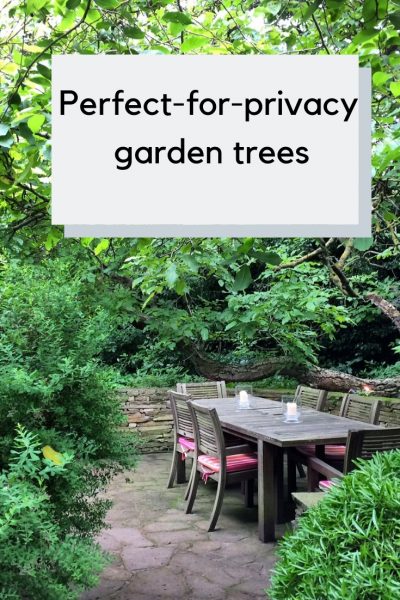

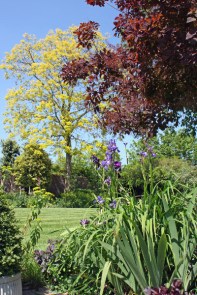
























Really useful info here. I’m currently seeking planning for a loft extension (to a bungalow) and the neighbouring properties are concerned by overlooking and privacy. I only have 4m to my boundary, but planning wants me to have 4-5m trees for their privacy from my upstairs windows. I’m stuck as I don’t want to shadow downstairs, but need to reduce/block the view from two upstairs windows. Any tall thin options that can be that close to a house?
Unfortunately there is a recommendation that any tree should be planted three quarters of its eventual height from a house, so a tall thin tree would have to be planted further away than the 4 metres to your boundary. Is there anything you can do with windows and design so that you get the light you need but don’t overlook the neighbours? It is a really tricky problem.
Really useful and informative article. It’s good to see realistic pictures and comments about exactly the type of trees needed and wanted by so many of us. I’ll be using your suggestions. Thank you.
Thank you!
DO NOT PLANT Pyrus calleyrana
HIGHLY INVASIVE
STOP THE INSANITY
Pyrus calleyrana is invasive in 25 states of the United States, so if you live in the US, it’s important to check whether it is invasive in your area or not. In the UK, it has not proved invasive. Invasive plants in the UK are on Schedule 9 of the Wildlife & Countryside Act, but Pyrus calleyrana is not on it. An invasive plant is not invasive in all areas – it’s just invasive if it’s introduced to a place where the growing conditions are particularly good for it, so ‘invasive’ in one place doesn’t mean ‘invasive’ in another. I hope that helps.
Hello, thank you for the article, I am giving my north facing over looked 20ftx30ft garden a make over, I have nosy neighbours to the right of me and to the back, I would like to plant trees for privacy and noise blocking, I love evergreen and I would like to attract the birds, I would like a garden full of shrubs, trees flowers and colour, I also need a corner for the grandchildren. Where do I start to with the privacy and nose blocking. Many thanks .
I don’t know if you’ve seen this post, but it gives the starting points when planning privacy in your garden. It’s very difficult to achieve complete privacy in a town, but you should be able to create some, so I hope this helps: /how-increase-garden-privacy/
Hello, great article, thanks. I am looking for a few medium sized trees for privacy to plant along a narrow (1.5ft) raised border along the back wall of my garden (20*10 foot). However my neighbour’s garden behind the wall is considerably lower than ours and I am worried about the roots of the tree destabilizing the wall as it hasn’t foundations – is this an issue I should consider? are there any trees that would be suitable for this situation? thanks!
Most tree roots don’t damage walls, but it’s always a good idea to plant the tree a few feet away from a wall or fence anyway, as neighbours may not want branches hanging over their side. If you don’t want all year privacy (if summer-only is fine for you), I’d suggest apple or crab apple trees, as the blossom, fruit and autumn colour is so lovely, and it’s wildlife friendly as well. We have a similar situation and have planted a quince tree and also a Turkish cobnut, both of which give us privacy without affecting the wall – we’ve planted them far enough away from the wall so their branches don’t hang over it, and the roots don’t generally go much further than the spread of the branches. It’s nice to have trees that you enjoy, as well as having them for privacy – another very pretty medium sized tree is the Ornamental cherry or ornamental plum.
This is the best article I have come across so far. I wasn’t sure what tree I need for my garden until now but now there are choices to make. Appreciate this informative post, great work and keep it going.
Thank you!
My garden is only 10m x 10m.
Currently have a beautiful field behind and neighbours on either side. A housing estate is due to be built on the rear field so I desperately need to find a way to increase my privacy and block the new houses out,
I have thought about having red robins along the rear fence and halfway along the side of the garden in raised beds with a trellis.
I really want privacy of up to 4.5 m high and evergreen but don’t know if this is the best solution given the size of the garden.
That does sound difficult, and I think you would find 4.5 metres quite tall. It may make your garden dark and it may also not be secure in high winds. Can you tell where the windows of the new houses will be facing? In terms of privacy, you only need to block the sightline/s from a window or windows that can see into your garden, rather than blocking everything off. You may find that a single tree with a spreading canopy, or a vase-shaped tree, will ultimately blur the sightlines over the whole garden. It’s also worth choosing a tree you like the look of, as it will be a focal point. I presume you’ve seen the other posts on privacy on the blog, such as this one: /how-increase-garden-privacy/ If you do want a row of trees, there’s an interesting row of lime trees in this post (they are pollarded every year so never shade the garden too much) : /secrets-contemporary-garden-design-cheap/ I hope that helps – very often it’s not a question of one single solution but putting things together – one tree near the end of the garden + a privacy screen around an eating area around the house, for example.
Can you recommend a small ornamental tree preferable with flowers/berries/autumn colour for a windy corner. It will be planted about 2 metres from boundary wall. Thanks for a great informative site
I wonder if Acer japonica ‘Aconitifolium’ might be good? There’s more about it here in this post. /six-top-shrubs-late-season-colour/. The post just before it also has some good autumn colour recommendations, and some general advice on choosing trees. /how-choose-garden-tree-brilliant-autumn-colour/ I hope that helps.
Thanks for this article, lots to think over. In our current house we have pyracantha (from previous owner) growing right up against the house wall – we’re on clay soil, is this plant okay to grow against house walls in that case? The house was here before the plant (if that makes a difference).
I understand from the RHS advice section on its website that there can be issues with pyracantha, so perhaps not the best choice for against the wall of a house. I’ve sent you an email with a link to that advice page.
hi there,
Need your help please, i am looking for some evergreen trees for the back of my garden for some privacy from my over looking neighbours . thanks
Which tree you choose depends alot on where the neighbour’s windows are, how big your garden is and where you want to feel private if it’s not possible to screen the whole garden. Probably the most important thing is to work out what the neighbours can actually see and only screen that. There isn’t a ‘best evergreen tree for privacy’ – just the best privacy solutions for you, and that varies hugely. I’d suggest reading the other posts on privacy to see if a hedge or screen might help too. They are here: /how-increase-garden-privacy/ and /new-directions-in-garden-privacy-screens/. Each post has links to other posts in it, so you should be able to find a number of options. I hope that helps.
Please do not promote the panting of more birch trees. This is one of the greatest causes of trouble for allergy sufferers and especially Oral Allergy Syndrome or Pollen Food Syndrome (PFS)
The most common pollen involved in PFS in UK sufferers is birch tree pollen; this is because the main allergen in birch pollen, Bet v 1, is highly cross-reactive to many plant foods.
https://www.allergyuk.org/assets/000/001/548/Oral_Allergy_Syndrome_original.pdf?1512985580
Thank you for putting this point of view and the link to the further information.
This article is so helpful, thank you.
I have a townhouse at the coast and the front is completely block paved. I’d like to make two small beds either side of the house with a Autumn Spire, Persian Spire or even a small ornamental cherry. They would be 8-10 feet from the house.
Is this a possibility or should I stick to shrubs?
I can’t give you a definite answer but Autumn spire and Persian Spire are generally considered good choices for a small space. And they are lovely trees. We have several ornamental cherries and they have not caused us any problems. The RHS says that trees normally pose no problem when planted close to houses, unless you have a heavy clay soil (small risk of subsidence) or old drains with poor seals, when the roots may be able to penetrate the drains. However small trees, particularly fruit trees, are the least likely to cause problems.
Thanks for the reply, I’m in Ramsgate, not that far from Faversham so I’m assuming I have chalk soil.
I’ll start planning for next year and report back!!
I really want to ‘green up’ my front!
Yes, probably chalk soil, I think there are some nice cliffs near you.
Just to say, I’m not the proud owner of a 10’ Sorbus Autumn Spire.
I wasn’t going to do it this year but a wonderful garden centre, in Preston, Kent, had the tree I wanted so it moved forward really fast!
I had the block paving up in a 70cm x 150cm bed. It’s chalky soil. It looks wonderful and is already bright red!
That’s such a beautiful tree.
Fab article. I have a housing development planned next to my house which could mean 5+ houses right next to me. I have a 4foot stepped wall surrounding my property so would be after something that will not subsidise the wall (which is unlikely to have deep foundations). I’d prefer something evergreen. What would you recommend? Thank you.
Any of the trees in this post are unlikely to damage foundations – and in fact the RHS say that it’s unlikely any tree will damage foundations especially as it’s a good idea to plant it several feet away from the wall. If you plant it too close to the wall, then when it grows bigger, your neighbours are entitled to cut off overhanging branches, which could make the tree look ugly or lopsided. It’s difficult to be precise about which tree, as it’s so much a question of taste and I don’t know the situation. I’d suggest contacting one of the tree suppliers in this post (not a general garden centre) and talking through whether you want evergreen or deciduous trees. Tell them what soil type you have and whether the site is sunny or shady. Provided the wall is strong enough, you could also consider adding trellis to the top of the wall to take it to 2 metres. I hope that helps – not easy to find 5+ houses being built next to you.
Hello – thankyou for this article!
We have just moved into a new house on a new estate. The developers have put Rowan trees – the type that grow to 25-40 feet high – in front of the houses, about 5-7ft from the house, and a few feet from the drains, also near windows. I have asked that they be removed to avoid root damage to the drives and drains. We live in Middlesborough and wonder if you could recommend a small tree that won’t cause trouble or block too much light.
We have a standard style Magnolia in a pot that I thought could go one side but wonder whether is is suitable. Also what to put in the other side? after reading the article I wonder about crab apple?
Crab apples are wonderful trees for small gardens or spaces, so I think I would definitely recommend that. My favourite is Malus ‘Gorgeous’ because it has lovely blossom, and then hangs onto its fruit for much of the winter, so there’s always something to look at.
Hi ☺ Very helpful article for someone like myself who knows nothing about gardening. I would love to plant a couple of black cherry plum trees at the bottom of my garden next to my 6 foot tall fence. I read you should plant them 6-10 inches away from the fence. Will this prevent any roots damaging the fence and if I keep them more central in my garden will this prevent any damage to my neighbours at either side of me?
Thanks
It’s unlikely that cherry tree roots will cause damage to neighbouring gardens. The RHS advise that tree roots are unlikely to cause damage to buildings unless the buildings are pre 1950s and the soil is heavy clay. Cherry tree roots are shallow so they can lift paving, but the RHS says that provided there is no paving within one metre of the tree, then even lifting paving is unlikely. There doesn’t seem to be any record of tree roots damaging fences, but the main objection your neighbours may have is to over-hanging branches rather than roots. They’re entitled to cut off any branches that hang over their property and this may spoil the shape of the tree. So planting it away from a neighbour’s boundary may indeed be a sensible thing to do. It’s worth asking the grower what the final dimensions of the mature tree are likely to be and then plant it where its branches are unlikely to reach over the fence. Alot of cherry trees have a nice upright or ‘vase’ shape, rather than having spreading branches and this makes them a good choice if you want a tree that is going to keep to its own garden. Hope that helps, with best wishes, Alexandra
Interesting article, thank you. I’m looking for trees for screening that do not take much pruning as both my partner and I have mobility problems. They need to be quite tall ( four metres) as this is to obscure my local councils 360 degree viewing scope, CCTV surveillance camera which stands in the car park next to my garden and has the scope to spy on the whole of my back garden and bungalow. Currently we are having to keep the blinds closed in the living room and kitchen, and cannot go out into the garden without being spied on, (you can watch the CCTV go round in a tour pattern circuit past our garden and home) I have spoken about Human Rights to privacy being violated, but they refuse to remove it. So the only solution we can see is to plant screening trees, I’ve looked at the Photinia but for this size they are over £300 per tree, we’d be grateful for your advice.
I think that a row of screening trees might make your garden dark. I’d suggest distraction screening instead. CCTV isn’t usually of the highest quality so just one or at the most two trees between you and the camera will mean that it’s unlikely anyone will actually be able to see what you’re doing. I’ve gone into this in these two posts: /new-directions-in-garden-privacy-screens/ and /new-directions-in-garden-privacy-screens/
If you plant or put a low screen (no more than 4-5ft high ) a few feet away from your window, then the camera can’t see inside your house. Similarly, if you decide where you want to sit in the garden, a low screen, trellis or hedge (no higher than the height of a man sitting) positioned near the table will give you privacy without blocking too much light. Most small trees lose their leaves in the winter, so if you want evergreen cover, what about holly or Portuguese laurel? In the end, all trees do have to be maintained, but you should be able to keep one in check by engaging someone to prune it every three years or so. I hope that helps – you have my sympathy – I don’t think any of us realise how much we are captured on CCTV as we go around our daily lives even if we haven’t got a camera facing the garden.
Hello.
Thank you for such an lovely article – it’s been incredibly helpful.
I’m desperate to plant a Ceanothus arboreus (‘Trewithen Blue’ ) – they’re so beautiful but can grow overwhelmingly large!
Do you have any advice on keeping it under control – can I prune it into shape?
Thank you!
Yes, you can prune any shrub or tree into shape – and there’s some specific advice on ceanothus here from the RHS:https://www.rhs.org.uk/advice/profile?pid=354 I note that it says that overgrown evergreen ceanothus don’t respond well to hard pruning, and I have certainly killed a couple in my time by ignoring them for years and then suddenly hacking away so it’s worth staying on top of the size and shape from the beginning rather than only pruning when it gets too big. I hope that helps.
Hi
It would be useful to post which of the trees shed leaves in winter. Apart from the evergreen which i know doesn’t.
I have a large garden and i love my lawn. All the current trees i have shed no leaves in winter so my lawn is leaf free.
Could you say which ones shed leaves and which dont.
All trees shed leaves at some point. Evergreen trees shed them slowly throughout the year, so you don’t really notice them. All non-evergreen trees (deciduous) shed their leaves in the autumn (fall).
I have a narrow yard where neighbors built a two story addition with windows looming onto my yard. Their building is 4 feet from my fence. I am trying to find a cost effect privacy screen that needs to reach about 16 feet. My lot is narrow, so this has to be planted as close as possible to my wooden 7 ft fence. Will birch trees work. Evergreens would be best but so costly. Any suggestions
A birch tree would probably be a good choice, or any fruit tree that grows up in a vase shape. It’s a good idea to go to a local tree nursery and discuss it with the growers – the advantages of a nice vase shape is that it will screen you higher up while not taking up space at ground level. To keep a vase shaped tree (I have two ornamental cherries ‘Snow Goose’ and two crab apples ‘Malus hupehensis’, just cut away any branches that aren’t going in the right direction, so pruning isn’t difficult. I hope this helps.
I found this post while researching creating a privacy hedge. Thank you so much for your column. I live in a community in which there is a maintenance service. I have a corner lot and my backyard is cornered by one very busy and one busy street. I am partially protected from the busiest street by a high brick wall that belongs to the association. After the brick wall is a tall wrought iron fence. The fence by the busy road had a large climbing vine or bush that obscured about 60% of the busy road. But, last fall I came home from work to find that the association had completely removed it and now my porch and backyard are completely exposed to the road. I need to plant something quick growing that will obscure the road. I have about 30 feet to cover. What plants or trees would you suggest? This problem is particularly troubling to me since I am considering selling this house with the next two years to downsize. Thank you for your help.
It’s quite difficult to say without knowing what soil and climate you have. I would suggest visiting a local plant growing nursery where there are horticultural experts (ie not a large garden centre where the staff may not know alot about plants) and discuss the matter with them. If you don’t have the right sort of plant nurseries nearby, I’d suggest finding some tree, shrub and climber nurseries on the internet and discussing it with them by email or phone. If you have a photo of the previous bush/climber and/or the spot you want to fill, then show it or send it to them. I’m sorry not to be more specific, but your growing conditions will make a big difference to how fast the plant grows or whether it is locally considered invasive, but I hope that helps.
Really helpful reading this article and the following conments, thank you! Our problem is most of our garden is to the front of the house and very exposed. We are at the bottom of a hill , in a conservation area and our garden slopes down away from the house and is very overlooked. We have a wonderful view of the village from our house so dont want to block it too much with anything too tall but could do with something with a wide spread maybe? Our kids love to play out the front garden but I’m always very aware of how exposed they are. Oh and our soil is very clay!. Any advice would be appreciated.
It’s quite a tricky one, but if there is a slope down, then a reasonably high hedge or fence would protect your children without affecting your view too much. I’d suggest a really reliable and easy-to-grow hedge, such as Portuguese laurel or privet. I don’t know if you’ve seen this post on Hedges:/what-you-really-need-to-know-about-hedges-for-privacy/ which has several options, all of which should be fine in clay. I’m sorry it’s taken me a while to answer this – I’ve been travelling, and disconnected from my laptop. But I hope that helps.
Definitely the most informative article I’ve read on this subject – really useful, many thanks Alexandra :)
Hi, I have a smallish garden with a 6ft fence but the neighbours garden is raised so would like more privacy.
I’m wondering what low maintenance screening would be best which wouldn’t grow to quick as only want it around 9ft or so.
Thanks
If you get on with your neighbours, perhaps you could consider adding a trellis to the top of the fence, with climbers. If they don’t want that, then I’d suggest perhaps screening your seating area, so the screen is close to you. That can be trellis or hedging. If the low fence is at the end of the garden, would it be worth planting a slightly higher screen further forward, so that you can hide compost, log store, shed etc behind it, and get more privacy at the same time? The nearer the screening is to your house or where you sit, the more privacy you will get.
Thanks for this great post! Now seen that we could plant a bigger tree 2/3 the way top the garden to much better effect than lots of trees on the end of the garden (near to what we want to screen).
I am so glad I have come across your post!
Current dilemma:
Large exposed garden with clay soil. we need some evergreen screening to one side, that is quick growing (and that isn’t conifer/leylandii!)
Can you recommend a tree that would tick those boxes? Thank you :)
In terms of hedging: Privet (ligustrum) is really quick growing, as is cherry laurel (prunus laurocerasus). Both are also hardy in exposed conditions, but the privet may lose some leaves in a harsh winter. They’ll usually regrow. Photinia x fraseri ‘Red Robin’ is also fast-growing and hardy in a cold winter. It may also be worth considering bamboo, provided you make sure you don’t get the ‘invasive’ variety that spreads. If you’re tempted by bamboo, google a specialist nursery so you can discuss your specific conditions, as bamboos vary in their hardiness. Hope that helps.
Good article and comments for me to read helping with my current dilemma but interested to hear more thoughts on my particular issue. Have a conifer hedge approx. 9ft – 10ft tall around 3 sides of my rear garden. It’s about 1.5metres thick. Lots of brown dead patches. We’ve been in the house for 2 years and now looking to lay a patio. Patio layer has said conifer roots will cause a problem – that part of the garden is raised up steps from the rest so its something to do with physical roots and the way the ground will change with varying amounts of moisture I believe. We are swaying towards getting rid of entire hedge of conifers (approx. 45 trees) but would be left quite exposed to the houses down the road and across the street so need a fairly quick screening solution. I am guessing that anything planted would cause a problem to a patio with roots eventually so I am wondering if we are best to keep something in pots. Interesting someone mentioned troughs and it’s got me thinking that if I found the right containers or cladded some containers they could be quite a nice feature. Appreciate any comments and advice on this – so far thinking pleached hornbeam from a quick google search but I am no gardener whatsoever so out of my depth here. please help :)
I would get a second opinion on the subject of roots. Some roots of some trees do rise up and cause problems – for example, prunus, but not to the extent that many people fear. A patio layer is not necessarily horticulturally qualified to say which tree roots will cause a problem for your patio. It sounds as if your hedge isn’t looking great anyway, so perhaps the question to ask is ‘do I want an excuse to get rid of it anyway?’. Hornbeam roots shouldn’t cause you a problem. According to the RHS, problems with tree roots pushing up paving generally only happen within 1 metre from the tree – and you shouldn’t pave within one metre of a tree anyway as that will reduce the amount of rainfall it receives.
Because there are so many factors – your soil, your sightline, what trees grow well in your area, etc I think you need to discuss this with a hedge or tree supplier to get specific advice. Look up specialist companies near you as you can’t rely on the qualifications of people, say, at a local garden centre. If you get rid of a well established conifer hedge, you’ll need some major works to get rid of the stumps, and I’d then advise a mix of new topsoil and well rotted manure to give the new hedge the best possible start. The soil will be very depleted by the conifers – but you may end up with a much nicer hedge at the end of it. Good luck.
We are moving into a new build and picked off plan now the house is built we realise the house round the cornerr is much closer at the back than we thought. We want tob immediately plant screening that will grow very quickly to obscure the house. Any suggestions please
I would suggest drawing up a brief, then going to a local tree or hedge nursery (not a garden centre, but a specialist grower). The questions you need to answer for the brief is ‘Do we want to block a sightline (ie just from one or two windows) or do we want a complete screen?’ ‘Do we want to buy mature trees or hedging (expensive) or are we prepared to wait a few years for younger trees or hedges to mature? Do we want evergreen coverage or are we happy to have deciduous (Evergreen are subject to more regulations)? Would you be happy with a private area in the garden or do you want to screen as much of the house as possible? It’s difficult to screen a whole house, especially in a smaller space, but if you decide exactly where you want the privacy or exactly what you really don’t want to see, then it makes choosing easier. Fast-growing, by the way, usually means that it needs regular pruning once it comes to maturity. Bamboo is worth considering, but make sure that your supplier sells you the non-spreading kind. I hope that helps.
We have recently moved to a house with a smaller garden and want to replace a very large laurel that is maybe 10ft tall with a slim but fast growing conifer or taxus. We like Cupressus but they are slow growing and the larger ones are expensive. Can you recommend? We do have a stunning Cotinus Obovatus tree next to the huge laurel which is definitely staying in the put!
I’d recommend looking at Thuja Green Giant and Italian Cypress, both of which are slim and fairly fast-growing. And avoid the Leylandii Cypress unless you’re happy to trim it every year – it quickly becomes a very large tree and shades everything. Younger trees are cheaper, and will grow to the height you want in a few years, older trees are more expensive but will give you the look you want immediately.
Really cool site. We’re trying to screen a neighbours tree house built right in the boundary. We have veg patches in front and fruit climbers on the fence, so looking for something that will get to 4m or so, be pruned to keep a sensible spread and won’t block all light from the veg or fruit. Any ideas?
Quite tricky. If you only want to screen it in the summer, when people may be out in the garden, then I’d suggest a deciduous tree, like a fruit tree, because that fits with the other fruit and veg in the area. I’ve found crab apple surprisingly good for screening, though it will take 2+ years before it’s properly established. I’ve also seen espaliered apple trees look beautiful. Espaliered trees don’t have much spread, so should minimise the loss of light. It’s worth being realistic – anything that blocks the view will make the veg patch more shady, but most salads and many herbs like it that way. And runner beans seem to grow wherever you plant them. Hope that helps.
Hello, I love this blog. So informative
I am looking to buy a small ish tree for my front garden. It is a very sunny spot. It would be planted about 2.5 meters from front of house.
I have a japanese maple and cherry tree in my back garden and so could go for one of these but I have fallen in love with the sweet gum (liquidambar).
I see one on my school run everyday and in autumn I think it is the most gorgeous tree and it cheers me up every day.
The one you have seems the perfect size – where did you get it from and how old is it and how big will it grow?
If it could stay the size it appears in your photograph I would get one without hesitation but when I look at google images some pictures look huge and websites say it can get to over 20 meters.
Liquidambar is a wonderful tree – I’ve just planted another myself. My first one was quite slow-growing, but they can grow at the rate of about a foot a year. But they do respond well to pruning, and a well-pruned tree is a joy to behold. However unless you know you’ll prune it every year, I’m not sure it is the best tree for a limited space and close to the house. Why not consider Amelanchier lamarkii instead? I have several friends who grow this in their front gardens, and it has dazzling white blossom in spring, berries (which vanish quickly) then glorious autumn colour. I think it’s a bit easier to keep under control – my neighbour’s trees are still quite modest and they are nearly 20 years old.
We are just about to purchase a period house with a medium small garden. The sale may fall through if we can’t find a way to block the view to the rear of a row of houses iveroooking the garden. They are set some 5-10m away from the garden and are 3 story high. We need something to draw attention away from them and to a beautiful tree or plant.
The site is some 10m long with a wall at the perimeter and a large sycamore in the top corner of the garden with the buildings flings to the left. Light is limited too.
It might be better to create private areas in the garden rather than aiming for privacy in the whole garden. Or if it’s the sight of the row of houses you don’t like, then you could decide where you will sit and/or eat out in the garden and block the sightline from those areas only. There are a few more ideas here in this YouTube video:https://youtu.be/jojmMHhRjxY. And if you haven’t seen these 2 posts, they have more ideas too:/fences-for-privacy-great-ideas-garden-screening/ and /what-you-really-need-to-know-about-hedges-for-privacy/. The link you included in your comment didn’t work, by the way, so I can’t comment on it. But I hope this helps.
This is the best article I have read on trees for privacy…thank you. I need to screen a neighbours window (about 40feet away that they have just installed) Thank evergreen would be best.
My main concern now however, is the Red Robin tree I put in three years ago. It is covered in spots and the leaves are limp. What can I do not to loose it. I am into wildlife and hate to use harsh chemicals…is there an alternative please.
Thanks for your time, Elaine
It’s difficult to know what’s wrong with your Red Robin without seeing it, but here is a link to the RHS advice guides – scroll down to ‘problems’.https://www.rhs.org.uk/advice/profile?PID=145#section-5 It looks as if you may be able to rescue it by feeding it and improving the drainage around it. Good luck.
Thanks for an interesting article. Do you know which of the above trees can tolerate winter temperatures of -20 centigrade? Thanks from a Canadian!
Betula papyrifera, also known as native white-barked birch, paper birch or white birch is suitable for very northern climates (up to US Hardiness Zone 3). Amelanchier lamarckii should be safe down to minus 28 degrees Centigrade occasionally and should be able to cope with -9 regularly, according to the RHS. And Malus (crab apples) are also considered hardy in very cold winters. It’s a good idea to see what trees do well in your neighbours’ gardens because it’s not just temperature that affects the trees, it’s also how exposed and windy the area is and what kind of soil it has. Hope you find one that you like.
The information on espaliered trees is very interesting–thank you.
Thank you.
Thank you for your very helpful article. I am wanting to plant some Pyrus calleyrana ‘Chanticleer’ along my boundary where a new development is completely overlooking my garden. How close do I plant them to create a complete screen? Also how long to they take to grow up to 20 feet?
It’s difficult to be exact as to how quickly a tree grows, because it depends so much on how big it is when it is planted, growing conditions, aspect etc, but ‘Chanticleer’ is regarded as a ‘medium-fast’ grower. I’ve seen several local specimens grow from spindly young whips into trees that provide good cover in around 4 years. Plant 6 metres or 18 feet apart for continuous cover. Trees that are treated well grow better than those that are neglected so discuss feeding and watering regimes with the grower and follow them carefully for the first few years. Pyrus calleyrana are pretty tolerant and hardy, but giving them the right amount of water and nutrition can only help. 20ft is around half the eventual height, so you can probably buy young trees that are not far off that height now. There is a rule of thumb that says that the younger and smaller a tree is when you plant it, the faster it will establish and the better it will grow. And it’s cheaper to buy younger, smaller trees. However, if you want a quicker screen, maybe buy trees that are almost the height you want them at.
Hello. In process of removing very large {inherited} goat willow in back garden. Needed pollarding every 2 yrs. And canopy just got more and more dense! Would like to replace it, just approx. 6ft to the side. Have got my eye on a betula pendula golden beauty. Reaches a mature height of approx. 23′ at about 20yrs. So they say! Want something with a really light open canopy, not too tall and preferably quite columnar so this would appear to fit the bill perfectly. Oh, and I’ve got a thing for limey/yellowy leaves. Before I actually commit to buying, I just want to know if I’ve been ‘led up the garden path’ so to speak? Are you going to tell me it’s completely unsuitable as it grows to be a monster, or spreads to be 50′ wide???
It seems fairly certain that Betula pendula ‘Golden Beauty’ will stay under 25ft, and will probably only be about 16-20ft high at 10 years old. It looks like a beautiful tree, and is also reasonably columnar, which means it won’t have a broad spread. A rather lovely and unusual choice in my opinion!
Thank you so much for this article. The south facing part of my garden can be made into a sanctuary except for the bed room windows of the neighbours dormer bungalow which I can see and which make me uncomfortable. I guess I need something about 4 meters tall which is not too dense to make my garden totally private. What would you suggest?
What about bamboo? It grows well in pots and easily gets to 4 metres high. If it’s in a pot you need something that’s about 2ft high but quite wide – bamboo roots are not deep but they do need some sideways space. If growing into the ground, make sure that the bamboo species you choose isn’t one that spreads too much! Otherwise many people also like having two posts with strong wires stretched between. Then use it as a frame for an evergreen clematis, such as clematis armandii.
A pergola with vines climbing over it would also be private – pergolas are restricted to 2.5 metres high by law but once the vine had grown over it, you would be quite private underneath it (and just in front of it if you want to catch the sun’s rays.) I hope that helps.
Are there any trees suitable for all year round privacy that can be grown in large pots rather than planted? Thanks
Many people grow bamboo in large pots – and they make excellent screens as they grow tall, but filter the light and don’t hang over into a neighbour’s garden. If it’s trees you want, all trees will grow in pots but the size of the pot will affect how tall they grow. So buy the biggest container you can afford or get into the space. A friend of mine uses agricultural feeding troughs or you could look at adapting other large industrial containers.
Thuja is a fast-growing evergreen that would do well in a pot as it doesn’t mind poor soil. Otherwise a shrub which will grow large is a good option – Photinia Red Robin is one many people choose. All plants will take some time to get to their final height, so unless you buy at the height you need the privacy won’t be instant. And don’t forget to feed them regularly and change the soil around once a year. Hope that helps and do let us know how it goes.
Thanks ever so for your ideas on trees for privacy. Have a grotty looking 32 year old leylandii hedge which I lowered in height. Also removed the lower branches to get at the ivy growing through it. Not much privacy, as I live on a slope with houses above and below. Have considered a tree of some sort to eventually replace the old hedge, so either a hornbeam or birch would fit the bill. Space is at a premium, so only room for one tree at best.
Good luck with your eventual choice. I think the issue of trees and privacy must be one of the trickiest for gardeners.
Thanks for the article Alexandra, you’ve featured some beautiful trees. I’m currently facing this problem in a small section of my garden where all the screening trees have been cut down by my neighbours and we’ve had to take out a horrid Conifer hedge on our side so every bit of privacy has gone on both sides of the fence. We definitely need year round screening, perhaps you might consider doing another article on evergreen trees in the future? It would be really helpful!
Have you considered beech or hornbeam? Both hold their leaves in winter, so maintain screening. I will definitely have another look at evergreen trees – I think one of the keys is to make sure evergreens are well pruned and maintained, so they never get too big. Laurel and privet are good screeners. I will definitely return to this subject as it is a common Middlesized problem!
Very interesting post, we have three huge out of place conifers at the end of our smallish town garden planted and allowed to grow this tall by previous owners. Having them taken out at the end of the month and this is v informative in terms of thinking about what to replace them with. Thank you!
Ps. really like your blog as an aspiring but currently v amateur garden maker myself. Love the idea of restoring old gardens and using what you have to best effect.
Thank you – that’s great to hear. I bet you’ll love having the conifers taken out!
A very interesting and informative article, and you include some of my very favorite trees, particularly the Amelanchier. I do have an issue with one you suggest, the Pyrus calleyrana, and I hope that your readers in the USA do not take your advice on planting it. One of its relatives, the Bradford Pear, touted to be sterile, has crossed with other pears and produce prolific and invasive seedlings. It has become a real problem in the southeastern US. I do love your posts, but I felt I had to point out this one thing.
Thanks for pointing that out – nobody has mentioned a problem with invasive seedlings here, so perhaps ‘Calleyrana’ is better behaved than ‘Bradford Pear’. But I will ask around and see what the tree people say here. And thank you for your comments on the blog.
A fantastic and informative article you’ve got me hooked! However, like the lady who wrote a few days ago I too have the problem with land behind my house which the owner is apparently talking about trying to get building permits. If I were to plant a mix of evergreen trees in blocks would I be able to keep them as they were planted before the houses were there? If not I need to rethink my design as I have a 50m boundary to plant with only a willow and some lilac there at the moment.
A hedge is defined as three trees in a row, so if you planted three or more evergreen trees, it would come under the law for evergreen hedges regardless of when you planted them. Individual evergreen trees would often be OK, depending on any local covenants that you might have, but you can be compelled to cut down or reduce the height of a too-tall cyprus Leylandii. Depending on the size of your garden, you might consider staggering the trees rather than lining them on the boundary, and choose a mix of trees that you will really enjoy seeing, perhaps even a mix of deciduous and evergreen. It very much depends on where any windows in a new building are situated – all you need to do is block that sightline to give yourself privacy. Trying to block out the whole building is often too difficult. Also remember that the closer a tree or trees is to your house, the smaller it can be to give you privacy. I hope that helps.
What a useful article! Great recommendations – thank you. I would add the beautiful and unusual Persian Ironwood which doesn’t get huge and has beautiful leaves…. And about the Silver Birches – there are so many varieties, some are much more spectacular/good value than others.
Funnily enough, I had considered including Parrotia Persica (Persian Ironwood) as garden designer Caroline Garland recommended it. I did plant it myself once and it didn’t grow at all in 2 years, so I took it out, but I subsequently think that might have been our fault for putting it in a poor position. But people speak very highly of it, as another ‘perfect’ garden tree.